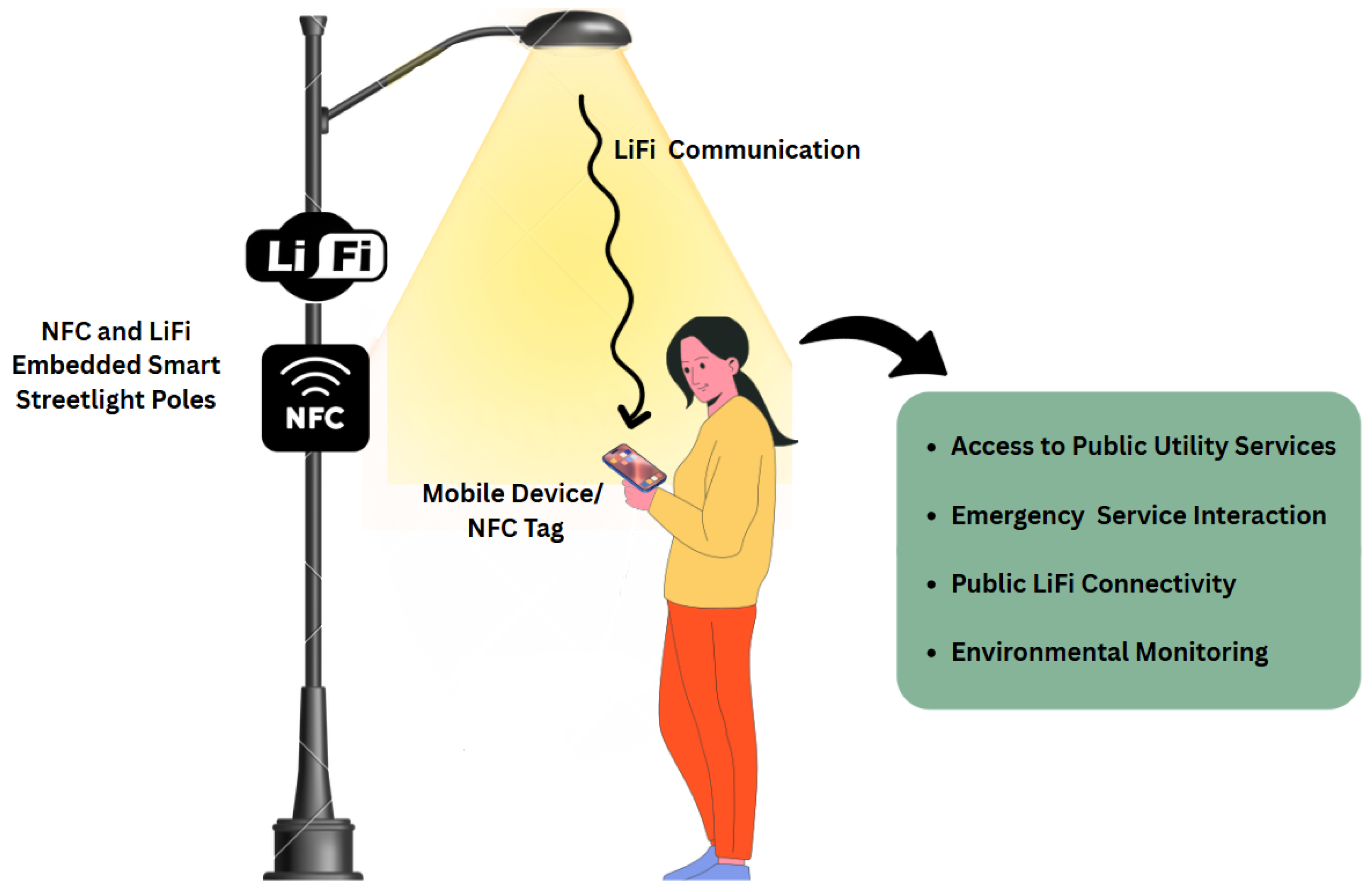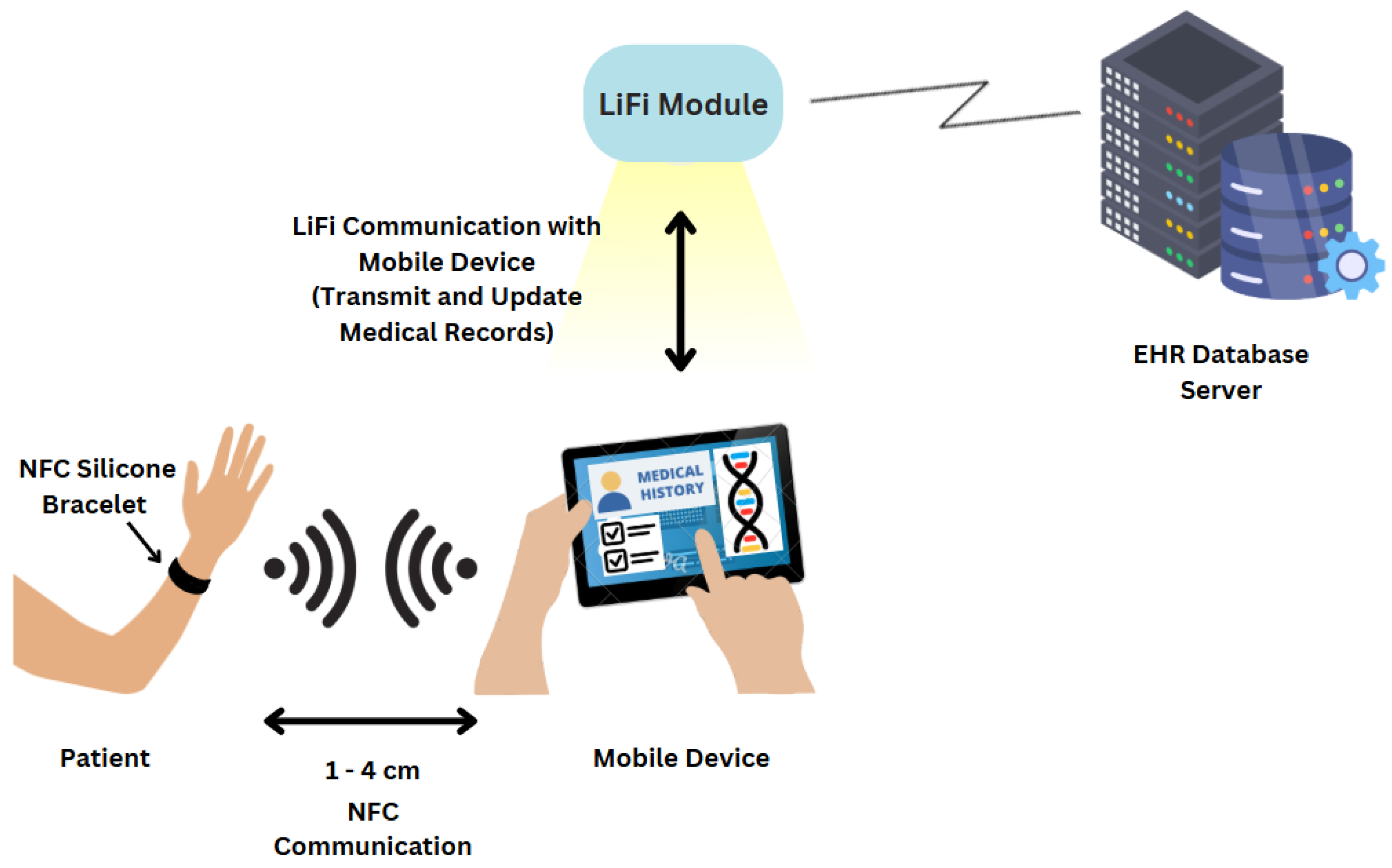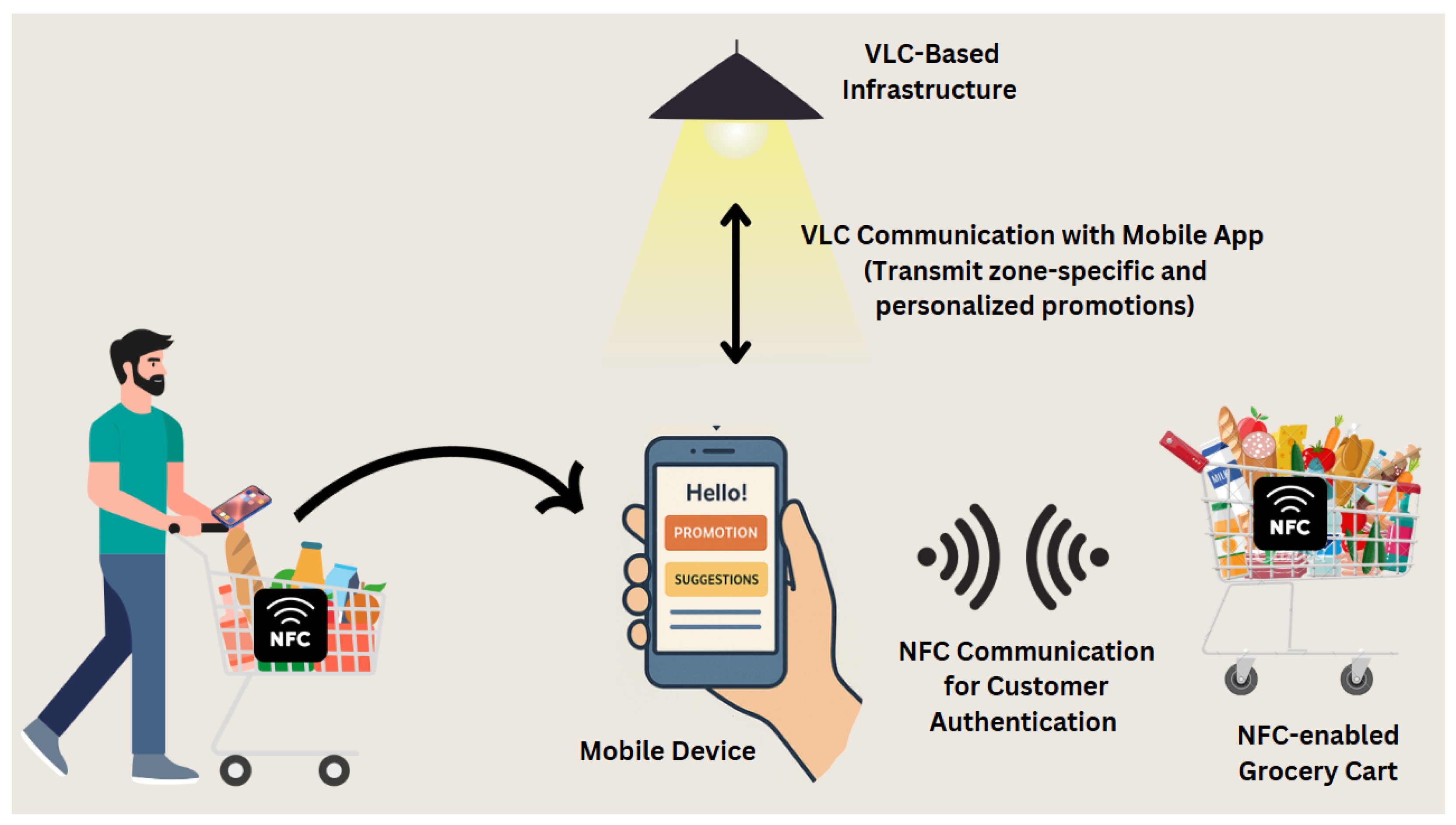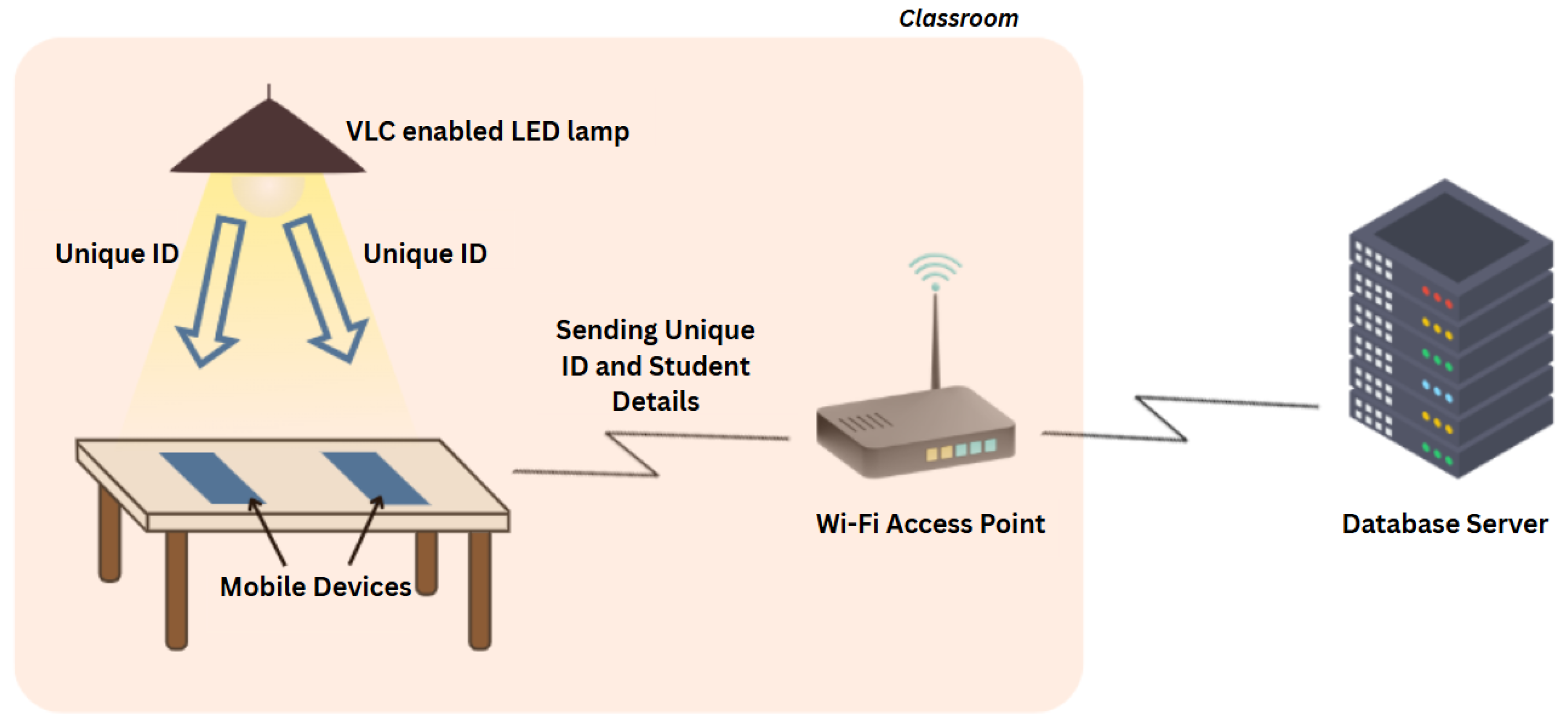Hybrid NFC-VLC Systems: Integration Strategies, Applications, and Future Directions
Abstract
1. Introduction
2. Fundamentals of NFC, VLC, and LiFi
2.1. Near-Field Communication (NFC)
2.2. Visible Light Communication
2.3. Hybridization of NFC with VLC/LiFi
2.4. Integration Strategies
2.4.1. NFC-VLC for Smart Retail
2.4.2. Secure IoT Pairing with NFC-LiFi
2.5. Technical Enablers
2.5.1. Unified Protocols
2.5.2. Energy Harvesting
2.6. High-Brightness Light-Emitting Diodes (LEDs)
2.7. Advanced Modulation Schemes
2.8. High-Speed Photodetectors
2.9. MIMO (Multiple-Input Multiple-Output) Technology
2.10. Channel Estimation and Equalization Techniques
3. Applications
3.1. Smart Cities: Smart Street Lighting Networks
3.2. Healthcare: Secure Patient Data Management
3.3. Smart Retail: Personalized and Interactive Customer Experience
3.4. Education: Automated Attendance Systems Using NFC and VLC
4. Challenges and Future Directions
5. Conclusions
Author Contributions
Funding
Institutional Review Board Statement
Data Availability Statement
Conflicts of Interest
References
- Volpentesta, A.P.; Frega, N. Modeling NFC-triggered user interactions with simple services in a smart environment. In International Conference on Enterprise Information Systems; SCITEPRESS: Setúbal, Portugal, 2015; Volume 2, pp. 96–104. [Google Scholar]
- Haas, H. LiFi is a paradigm-shifting 5G technology. Rev. Phys. 2018, 3, 26–31. [Google Scholar] [CrossRef]
- Katz, M.; Ahmed, I. Opportunities and challenges for visible light communications in 6G. In Proceedings of the 2020 2nd 6G Wireless Summit (6G SUMMIT), Levi, Finland, 17–20 March 2020; pp. 1–5. [Google Scholar]
- Aguilar, S.R.; de Mendivil, Í.S.M.; Pardo, M.B. NFC and VLC based mobile business information system for registering class Attendance. IJIMAI 2020, 6, 71–77. [Google Scholar]
- Niu, J.; Gu, F.; Zhou, R.; Xing, G.; Xiang, W. VINCE: Exploiting visible light sensing for smartphone-based NFC systems. In Proceedings of the 2015 IEEE Conference on Computer Communications (INFOCOM), Hong Kong, China, 26 April–1 May 2015; pp. 2722–2730. [Google Scholar]
- Liu, Y.; Ouyang, C.; Wang, Z.; Xu, J.; Mu, X.; Swindlehurst, A.L. Near-field communications: A comprehensive survey. IEEE Commun. Surv. Tutor. 2024, 27, 1728–2687. [Google Scholar] [CrossRef]
- Gupta, K.; Bhanodia, P.; Sethi, K.K.; Rajput, S.; Patidar, M.; Iyer, V.H. A Review on NFC for Secure Transaction its Fundamental Challenges and Future Directions. In Proceedings of the 2024 International Conference on Advances in Computing Research on Science Engineering and Technology (ACROSET), Indore, India, 27–28 September 2024; pp. 1–7. [Google Scholar]
- Coskun, V.; Ozdenizci, B.; Ok, K. The survey on near field communication. Sensors 2015, 15, 13348–13405. [Google Scholar] [CrossRef] [PubMed]
- Liu, Y.; Wang, Z.; Xu, J.; Ouyang, C.; Mu, X.; Schober, R. Near-field communications: A tutorial review. IEEE Open J. Commun. Soc. 2023, 4, 1999–2049. [Google Scholar] [CrossRef]
- Nikitina, K.; Melnikova, M.; Biliatdinov, K. Analysis of NFC technology evolution. Int. J. Open Inf. Technol. 2024, 12, 49–54. [Google Scholar]
- Cevik, T.; Yilmaz, S. An overview of visible light communication systems. arXiv 2015, arXiv:1512.03568. [Google Scholar] [CrossRef]
- Edirisinghe, E.; Karunarathna, P.; Dissanayake, D.; Godaliyadda, G. Design and implementation of a bi-directional visible light communication system. In Proceedings of the 2015 IEEE 10th International Conference on Industrial and Information Systems (ICIIS), Peradeniya, Sri Lanka, 18–20 December 2015; pp. 519–524. [Google Scholar]
- Vijayakumari, K.; Anusudha, K. A Comprehensive Study on the Advances and Challenges in Visible Light Communication Technologies. In Proceedings of the 2024 Third International Conference on Smart Technologies and Systems for Next Generation Computing (ICSTSN), Villupuram, India, 18–19 July 2024; pp. 1–6. [Google Scholar]
- Chandra, A.; Khandelwal, R.; Jain, N.; Gupta, S.; Singh, R.R. Performance Evaluation and Analysis of Visible Light Communication for Indoor Data Transfer using LED Technology. In Proceedings of the 2024 Fourth International Conference on Advances in Electrical, Computing, Communication and Sustainable Technologies (ICAECT), Bhilai, India, 11–12 January 2024; pp. 1–5. [Google Scholar]
- Qian, S. Visible Light Communications with Image Sensors. In Proceedings of the 2024 9th Optoelectronics Global Conference (OGC), Shenzhen, China, 10–13 September 2024; pp. 69–72. [Google Scholar] [CrossRef]
- Ariyanti, S.; Suryanegara, M. Visible light communication (VLC) for 6G technology: The potency and research challenges. In Proceedings of the 2020 Fourth World Conference on Smart Trends in Systems, Security and Sustainability (WorldS4), London, UK, 27–28 July 2020; pp. 490–493. [Google Scholar]
- Edirisinghe, S.; Lim, C.; Nirmalathas, A.; Wong, E.; Wang, K.; Alameh, K. Dynamic tuning of contention window for optical wireless networks. In Proceedings of the Optical Fiber Communication Conference, San Diego, CA, USA, 11–15 March 2018; Optica Publishing Group: Washington, DC, USA, 2018; p. M2K–8. [Google Scholar]
- Rajahrajasingh, H.; Edirisinghe, S. The feasibility of visible light communication for deep sea communication. In Proceedings of the 2023 IEEE 17th International Conference on Industrial and Information Systems (ICIIS), Peradeniya, Sri Lanka, 25–26 August 2023; pp. 152–157. [Google Scholar]
- Jayaweera, V.L.; Peiris, C.; Darshani, D.; Edirisinghe, S.; Dharmaweera, N.; Wijewardhana, U. Visible Light Communication for Underwater Applications: Principles, Challenges, and Future Prospects. Photonics 2025, 12, 593. [Google Scholar] [CrossRef]
- Li, J.; Ge, C.; Xu, C.; Gong, J.; Gui, W.; Zhang, C.; Liang, X.; Ding, W. Vlocsense: Integrated vlc system for indoor passive localization and human sensing. In Proceedings of the 30th Annual International Conference on Mobile Computing and Networking, Washington, DC, USA, 18–22 November 2024; pp. 2022–2027. [Google Scholar]
- Teng, C.C.; Bishop, M.; Brown, J.; Hansen, A.; Kleinman, R.; Palmer, N. Personalized shopping experience with NFC smartphone apps and electronic shelf label. In Proceedings of the Sixth International Conference on Advances in Human oriented and Personalized Mechanisms, Technologies, and Services, Venice, Italy, 27 October–1 November 2013; Citeseer: Princeton, NJ, USA, 2013; pp. 7–11. [Google Scholar]
- Pham, A.T.; Thang, T.C.; Villegas, J.; Cohen, M. VLC-based smart supermarket (SMARTKet): Key concepts and enabling technologies. In Proceedings of the 2017 IEEE 6th Global Conference on Consumer Electronics (GCCE), Nagoya, Japan, 24–27 October 2017; pp. 1–2. [Google Scholar]
- Fan, K.; Zhang, C.; Yang, K.; Li, H.; Yang, Y. Lightweight NFC protocol for privacy protection in mobile IoT. Appl. Sci. 2018, 8, 2506. [Google Scholar] [CrossRef]
- Dreyer, J.; Fischer, M.; Tönjes, R. NFC Key Exchange-A light-weight approach to authentic Public Key Exchange for IoT devices. In Proceedings of the 2021 IEEE 7th World Forum on Internet of Things (WF-IoT), New Orleans, LA, USA, 14 June–31 July 2021; pp. 374–379. [Google Scholar]
- Sethia, D.; Gupta, D.; Saran, H. NFC secure element-based mutual authentication and attestation for IoT access. IEEE Trans. Consum. Electron. 2018, 64, 470–479. [Google Scholar] [CrossRef]
- Ulz, T.; Pieber, T.; Höller, A.; Haas, S.; Steger, C. Secured and easy-to-use NFC-based device configuration for the Internet of Things. IEEE J. Radio Freq. Identif. 2017, 1, 75–84. [Google Scholar] [CrossRef]
- Linnartz, J.P.M.; Corrêa, C.R.B.; Cunha, T.B.; Tangdiongga, E.; Koonen, T.; Deng, X.; Wendt, M.; Abbo, A.; Stobbelaar, P.J.; Polak, P.; et al. Eliot: Enhancing lifi for next-generation internet of things. EURASIP J. Wirel. Commun. Netw. 2022, 2022, 89. [Google Scholar] [CrossRef]
- Lu, H.J.; Liu, D. An improved NFC device authentication protocol. PLoS ONE 2021, 16, e0256367. [Google Scholar] [CrossRef] [PubMed]
- Wang, H.Q.; Chi, X.F.; Zhao, L.L. Energy adaptive MAC protocol for IEEE 802.15. 7 with energy harvesting. Optoelectron. Lett. 2016, 12, 370–374. [Google Scholar] [CrossRef]
- Lazaropoulos, A.; Helen, L. Integration of LiFi, BPL, and Fiber Optic Technologies in Smart Grid Backbone Networks: A Proposal for Exploiting the LiFi LED Street Lighting Networks of Power Utilities and Smart Cities. Sustainability 2024, 16, 686. [Google Scholar] [CrossRef]
- Chandrakar, N.; Kaul, S.; Mohan, M.; Sai Vamsi, C.; Prabhu, K. NFC based profiling of smart home lighting system. In Proceedings of the 2015 International Conference on Industrial Instrumentation and Control (ICIC), Pune, India, 28–30 May 2015; pp. 338–341. [Google Scholar] [CrossRef]
- Baeza, V.M.; Sánchez-Fernández, M.; Armada, A.G.; Royo, A. Testbed for a LiFi system integrated in streetlights. In Proceedings of the 2015 European Conference on Networks and Communications (EuCNC), Paris, France, 29 June–2 July 2015; pp. 517–521. [Google Scholar] [CrossRef]
- Ebere, O.; Ramsurrun, V.; Seeam, P.; Katsina, P.; Anantwar, S.; Sharma, M.; Seeam, A. NFC tag-based mHealth Patient Healthcare Tracking System. In Proceedings of the 2022 3rd International Conference on Next Generation Computing Applications (NextComp), Flic-en-Flac, Mauritius, 6–8 October 2022. [Google Scholar] [CrossRef]
- Dacanay, K.; Guzman, V.; Estrada, F.; Abangco, J.; Co, H. NFC-Based Healthcare Information System: Enhancing Accessibility and Efficiency of Medical Data Management for Patients and Healthcare Personnel. In Proceedings of the 2024 12th International Conference on Bioinformatics and Computational Biology (ICBCB), Tokyo, Japan, 18–21 March 2024; pp. 137–143. [Google Scholar] [CrossRef]
- Tamazirt, L.; Alilat, F.; Agoulmine, N. A Visible Light Communication based positioning system for intuitive advertising in supermarkets. In Proceedings of the 5th International Workshop on ADVANCEs in ICT Infrastructures and Services (ADVANCE 2017), Evry, France, 1 November–1 December 2017. [Google Scholar]
- Garcia, E.; Rivera, H.; Ponder, N.; Kuo, R.; Zheng, J. Efficient and Cost-effective Class Attendance Management with a Smartphone-based System. In Proceedings of the Society for Information Technology & Teacher Education International Conference, Austin, TX, USA, 5 March 2017; Association for the Advancement of Computing in Education (AACE): Waynesville, NC, USA, 2017. [Google Scholar]
- Memane, R.; Jadhav, P.; Patil, J.; Mathapati, S.; Pawar, A. Attendance Monitoring System Using Fingerprint Authentication. In Proceedings of the 2022 6th International Conference on Computing, Communication, Control And Automation (ICCUBEA), Pune, India, 26–27 August 2022; pp. 1–6. [Google Scholar] [CrossRef]
- Sivalakshmi, P.; Kavitha, U.; Usha, R.; Pattanaik, O.; Maniraj, S.; Srinivasan, C. Smart Retail Store Surveillance and Security with Cloud-Powered Video Analytics and Transfer Learning Algorithms. In Proceedings of the 2024 Second International Conference on Intelligent Cyber Physical Systems and Internet of Things (ICoICI), Coimbatore, India, 28–30 August 2024; pp. 242–247. [Google Scholar]




| Feature | NFC | LiFi |
|---|---|---|
| Communication medium | Radio waves (13.56 MHz) | Visible light (LEDs) |
| Range | ≤10 cm | Up to 10 m (LoS-dependent) |
| Data rate | 106–424 kbps | Up to 10 Gbps |
| Security | High (proximity-based authentication) | Moderate (requires additional authentication) |
| Interference immunity | Susceptible to RF interference | Immune to RF interference |
| Power consumption | Low (passive tags available) | Moderate (requires illumination) |
| Typical applications | Contactless payments and secure access control | High-speed data transfer, smart lighting, and IoT |
| Key limitations | Limited range and bandwidth | Requires a line of sight and ambient light interference |
| Feature | NFC-VLC (Proposed) | VLC-RF [2,3] | VLC-OCC [12,18] | VLC-LiDAR [19] |
|---|---|---|---|---|
| Authentication | High (NFC proximity) | Low (RF reliant) | Moderate (camera-based) | None |
| Data Rate | Up to 10 Gbps (VLC) | High (RF + VLC) | Low (camera limits) | Medium |
| Range | NFC: ≤10 cm; VLC: ≤10 m | RF: Long; VLC: Medium | Short (LoS required) | Medium (LoS) |
| Security | Encrypted handshaking | RF eavesdropping risks | Limited (open LoS) | Minimal |
| Interference Immunity | High (VLC) | RF interference | Ambient light noise | LiDAR cross-talk |
| Applications | Secure IoT and healthcare | Broadband hybrid networks | Indoor navigation | Autonomous vehicles |
Disclaimer/Publisher’s Note: The statements, opinions and data contained in all publications are solely those of the individual author(s) and contributor(s) and not of MDPI and/or the editor(s). MDPI and/or the editor(s) disclaim responsibility for any injury to people or property resulting from any ideas, methods, instructions or products referred to in the content. |
© 2025 by the authors. Licensee MDPI, Basel, Switzerland. This article is an open access article distributed under the terms and conditions of the Creative Commons Attribution (CC BY) license (https://creativecommons.org/licenses/by/4.0/).
Share and Cite
Jayaweera, V.L.; Peiris, C.; Darshani, D.; Edirisinghe, S.; Dharmaweera, N.; Wijewardhana, U. Hybrid NFC-VLC Systems: Integration Strategies, Applications, and Future Directions. Network 2025, 5, 37. https://doi.org/10.3390/network5030037
Jayaweera VL, Peiris C, Darshani D, Edirisinghe S, Dharmaweera N, Wijewardhana U. Hybrid NFC-VLC Systems: Integration Strategies, Applications, and Future Directions. Network. 2025; 5(3):37. https://doi.org/10.3390/network5030037
Chicago/Turabian StyleJayaweera, Vindula L., Chamodi Peiris, Dhanushika Darshani, Sampath Edirisinghe, Nishan Dharmaweera, and Uditha Wijewardhana. 2025. "Hybrid NFC-VLC Systems: Integration Strategies, Applications, and Future Directions" Network 5, no. 3: 37. https://doi.org/10.3390/network5030037
APA StyleJayaweera, V. L., Peiris, C., Darshani, D., Edirisinghe, S., Dharmaweera, N., & Wijewardhana, U. (2025). Hybrid NFC-VLC Systems: Integration Strategies, Applications, and Future Directions. Network, 5(3), 37. https://doi.org/10.3390/network5030037






